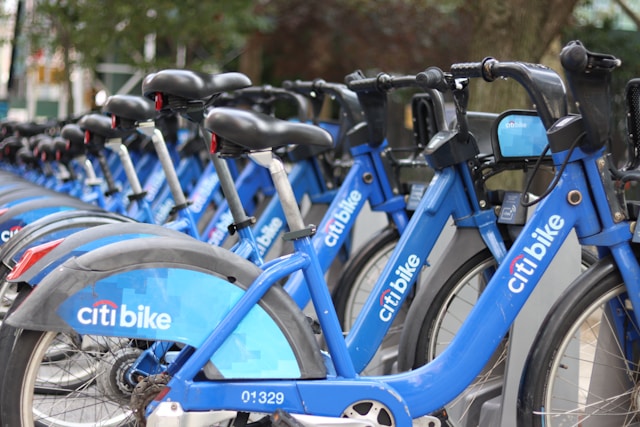Citi, one of the world’s largest and most influential financial institutions, has carved out a unique niche in the competitive banking sector. Its marketing strategy is a masterclass in aligning brand values with customer needs, leveraging digital innovation, and creating impactful campaigns that resonate across demographics. For marketing professionals looking to draw inspiration from successful big brands, Citi offers a compelling case study in how to blend tradition with modernity to achieve enduring relevance and growth.
Understanding Citi’s Brand Identity
Citi’s marketing strategy begins with a clear and consistent brand identity. This identity is built around core values of reliability, innovation, and customer-centricity. Citi positions itself not just as a bank, but as a partner in financial progress, helping customers achieve their financial goals through a wide range of services, from everyday banking to complex financial solutions.
The Citi Brand Promise
At the heart of Citi’s marketing efforts is the brand promise: to provide financial services that enable growth and economic progress. This promise is reflected in the company’s tagline, “Citi Never Sleeps,” which underscores its commitment to being available and responsive to customers’ needs around the clock. This message of relentless support and accessibility is a cornerstone of Citi’s communication strategy.
Digital Innovation and Customer Engagement
In an era where digital transformation is reshaping the financial services landscape, Citi has been at the forefront of leveraging technology to enhance customer engagement and streamline operations. The company’s marketing strategy heavily emphasizes digital channels, recognizing the importance of meeting customers where they are—online.

Mobile Banking and Digital Platforms
Citi’s investment in mobile banking and digital platforms is a key component of its strategy. The Citi Mobile app is a prime example, offering a seamless and intuitive user experience that allows customers to manage their accounts, make payments, and access a range of financial services from their smartphones. The app’s success lies in its ease of use, security features, and constant updates based on user feedback.
To promote its digital offerings, Citi has run several targeted marketing campaigns. One notable campaign is the “Banking at Your Fingertips” initiative, which highlighted the convenience and security of the Citi Mobile app through a series of engaging videos and social media posts. By showcasing real-life scenarios where the app simplifies banking tasks, Citi effectively communicated the value of its digital services to a tech-savvy audience.
Personalized Marketing through Data Analytics
Citi has also harnessed the power of data analytics to deliver personalized marketing messages. By analyzing customer behavior and transaction data, Citi can tailor its marketing efforts to individual preferences and needs. This approach not only enhances the customer experience but also increases the effectiveness of marketing campaigns.
For example, Citi’s “ThankYou Rewards” program uses data analytics to offer personalized rewards based on customers’ spending habits. By sending targeted offers and promotions, Citi ensures that customers feel valued and engaged, fostering loyalty and encouraging repeat business.

Creating Memorable Campaigns
Citi’s marketing campaigns are characterized by creativity, emotional appeal, and strategic use of media. These campaigns often go beyond promoting financial products to address broader themes that resonate with audiences on a deeper level.
The “Live Richly” Campaign
One of Citi’s most iconic campaigns is the “Live Richly” series, launched in the early 2000s. This campaign marked a departure from traditional bank advertising, which typically focused on product features and financial benefits. Instead, “Live Richly” emphasized the importance of enjoying life’s experiences and moments, positioning Citi as a partner in living a fulfilling life.
The campaign included TV commercials, print ads, and outdoor media, all featuring relatable scenarios that encouraged people to savor life’s simple pleasures. The tagline “Live Richly” became synonymous with a holistic approach to wealth, where financial security is a means to a richer, more meaningful life. This emotionally resonant message helped differentiate Citi from competitors and build a strong, positive brand image.
Sponsorships and Partnerships
Citi has also leveraged sponsorships and partnerships to enhance its brand visibility and connect with diverse audiences. Sports sponsorships, in particular, have been a significant part of Citi’s marketing strategy. The company’s sponsorship of the Citi Open, a premier tennis tournament in Washington, D.C., is a prime example. This sponsorship not only boosts Citi’s brand recognition but also aligns the company with values of excellence, perseverance, and global connectivity.
Additionally, Citi has partnered with major events and organizations, such as the Olympic Games and the PGA Tour. These partnerships provide platforms for Citi to engage with sports enthusiasts and showcase its commitment to supporting major cultural and athletic events.
Social Responsibility and Community Engagement
In recent years, there has been a growing emphasis on corporate social responsibility (CSR) and community engagement in Citi’s marketing strategy. Recognizing the importance of being a responsible corporate citizen, Citi has launched several initiatives aimed at making a positive impact on society.
The Citi Foundation
The Citi Foundation, the bank’s philanthropic arm, plays a crucial role in this aspect of the strategy. The foundation focuses on promoting economic progress and improving the lives of people in low-income communities around the world. Through grants and partnerships, the Citi Foundation supports programs in areas such as financial inclusion, youth economic opportunities, and urban transformation.
To raise awareness of its CSR efforts, Citi integrates these initiatives into its marketing communications. For instance, the “Pathways to Progress” campaign highlights the foundation’s work in providing young people with the skills and opportunities needed to thrive in the workforce. By showcasing real-life success stories and impactful projects, Citi reinforces its commitment to social good and strengthens its brand reputation.
Environmental Sustainability
Citi has also made significant strides in promoting environmental sustainability, which is increasingly important to today’s consumers. The company’s “Sustainable Progress Strategy” aims to finance and facilitate $1 trillion in sustainable activities by 2030. This ambitious goal includes investments in renewable energy, clean technology, and sustainable infrastructure.
To communicate its sustainability efforts, Citi launched the “Sustainable Progress” campaign. This initiative includes digital content, social media posts, and thought leadership pieces that highlight Citi’s role in advancing sustainable finance. By aligning its brand with environmental stewardship, Citi appeals to environmentally conscious consumers and stakeholders.
Global Consistency with Local Relevance
Citi’s marketing strategy is also notable for its ability to maintain global consistency while adapting to local markets. As a global bank with a presence in over 160 countries, Citi must balance a unified brand message with the need to resonate with diverse cultural and regional contexts.
Tailoring Campaigns to Local Markets
Citi achieves this balance by tailoring its marketing campaigns to reflect local values, preferences, and market conditions. For example, in Asia, Citi has focused on digital banking solutions that cater to the tech-savvy population. Campaigns in this region emphasize the convenience and innovation of Citi’s digital offerings, such as mobile banking and online investment platforms.
In contrast, Citi’s marketing in Latin America often highlights financial inclusion and accessibility, addressing the needs of underbanked populations. Campaigns in this region may feature testimonials from customers who have benefited from Citi’s services, reinforcing the bank’s role in fostering economic empowerment.
Local Partnerships and Sponsorships
Citi also leverages local partnerships and sponsorships to enhance its presence in different markets. In Mexico, for example, Citi’s subsidiary, Citibanamex, sponsors the popular soccer team Club América. This partnership helps Citi connect with passionate soccer fans and build brand affinity in the region.
The Role of Content Marketing and Social Media
Content marketing and social media play pivotal roles in Citi’s marketing strategy, enabling the company to engage with customers in meaningful ways and stay relevant in a digital-first world.
Thought Leadership and Educational Content
Citi regularly produces thought leadership content that addresses current financial trends, market insights, and economic forecasts. This content is disseminated through various channels, including the Citi blog, webinars, and whitepapers. By providing valuable insights and expert opinions, Citi positions itself as a trusted authority in the financial industry.
Educational content is another key aspect of Citi’s content marketing strategy. The company offers resources on topics such as personal finance, investment strategies, and retirement planning. These resources are designed to empower customers with the knowledge needed to make informed financial decisions, thereby strengthening their relationship with the bank.
Engaging Social Media Campaigns
Citi’s social media strategy focuses on creating engaging and shareable content that resonates with a wide audience. The company’s social media channels feature a mix of promotional posts, customer stories, behind-the-scenes content, and interactive elements such as polls and quizzes.
One successful social media campaign is the #StandForProgress initiative, which encourages users to share their stories of personal and professional progress. By highlighting diverse experiences and achievements, Citi fosters a sense of community and inspires others to pursue their goals. The campaign’s use of user-generated content also increases engagement and authenticity.
Navigating Challenges and Looking Ahead
Despite its successes, Citi’s marketing strategy is not without challenges. The rapidly evolving financial landscape, regulatory changes, and shifting consumer expectations require constant adaptation and innovation.
Adapting to Regulatory Changes
Citi operates in a highly regulated industry, and compliance with regulatory requirements is a critical consideration in all marketing efforts. The company must ensure that its advertising practices and communications adhere to legal standards and guidelines in each market. This requires close collaboration between marketing, legal, and compliance teams to navigate complex regulatory environments.
Addressing Consumer Trust and Privacy Concerns
In an age where data privacy and security are paramount concerns, Citi must continually build and maintain consumer trust. The company has implemented robust security measures and transparent data practices to protect customer information. Marketing campaigns often highlight these efforts to reassure customers of Citi’s commitment to safeguarding their privacy.
Embracing Technological Advancements
As technology continues to advance, Citi must stay at the forefront of digital innovation. This includes exploring new technologies such as artificial intelligence, blockchain, and fintech partnerships to enhance its offerings and improve the customer experience. The integration of these technologies into marketing strategies will be crucial for staying competitive in the future.
Five Key Lessons Marketers Can Learn from Citi
Citi’s marketing strategy exemplifies how a legacy financial institution can remain relevant and competitive in a rapidly changing world. By embracing digital innovation, delivering personalized experiences, creating impactful campaigns, and demonstrating social responsibility, Citi has built a strong and resilient brand.
Marketing professionals looking to draw inspiration from Citi’s success can learn valuable lessons in the importance of aligning brand values with customer needs, leveraging technology to enhance engagement, and creating campaigns that resonate on an emotional level. As Citi continues to navigate the challenges and opportunities of the financial landscape, its marketing strategy will undoubtedly evolve, offering further insights and inspiration for marketers around the globe.
Citi’s marketing strategy offers a wealth of insights for marketers looking to elevate their own brands. Here are five key lessons that can be drawn from Citi’s approach:
1. Consistent Brand Identity
Citi has maintained a clear and consistent brand identity that revolves around reliability, innovation, and customer-centricity. This consistency helps build strong brand recognition and trust. Marketers should focus on defining and sticking to a core brand message that resonates with their audience, ensuring that all marketing efforts align with this identity.
Lesson: Develop and maintain a strong, consistent brand identity that reflects your core values and resonates with your target audience.
2. Embrace Digital Transformation
Citi’s emphasis on digital innovation has been pivotal in meeting customer expectations and enhancing engagement. From mobile banking apps to personalized marketing through data analytics, Citi has effectively used technology to improve customer experiences. Marketers should embrace digital tools and platforms to stay relevant and connect with customers in meaningful ways.
Lesson: Leverage digital technologies to enhance customer engagement, streamline operations, and deliver personalized experiences.
3. Create Emotionally Resonant Campaigns
Citi’s “Live Richly” campaign is a prime example of how emotionally resonant messages can differentiate a brand and create lasting impact. By focusing on the emotional aspects of financial well-being rather than just product features, Citi connected with customers on a deeper level. Marketers should strive to create campaigns that evoke emotions and tell compelling stories.
Lesson: Design marketing campaigns that go beyond product features to evoke emotions and create meaningful connections with customers.
4. Leverage Sponsorships and Partnerships
Citi has effectively used sponsorships and partnerships to enhance brand visibility and connect with diverse audiences. From sports events to cultural partnerships, these initiatives have helped Citi reach new customer segments and build brand affinity. Marketers can benefit from identifying strategic sponsorships and partnerships that align with their brand values and target audience interests.
Lesson: Identify and leverage strategic sponsorships and partnerships to enhance brand visibility and reach new customer segments.
5. Commit to Social Responsibility
Citi’s focus on corporate social responsibility (CSR) and community engagement has strengthened its brand reputation. Initiatives like the Citi Foundation and sustainable finance efforts demonstrate the company’s commitment to social good. Marketers should integrate CSR into their strategies, showing consumers that their brand is dedicated to making a positive impact on society.
Lesson: Integrate corporate social responsibility into your marketing strategy to build trust and demonstrate a commitment to social good.

